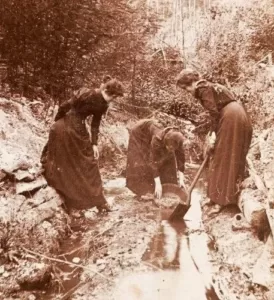From Australia’s Jewish Past:
The Jewish Emigration Society
Some interesting facts relating to the Goldfields and Immigration
First published in J-Wire March 31, 2021

One of the problems faced by the early Jewish gold-mining community was gender imbalance.
Naturally, there were far more men than women and significantly more single men than married men on the goldfields. The rough conditions on the fields in the early years were not perceived as ideal for women and children, so while there was some family life, the women-to-men ratio remained low throughout the first decades of the goldrush. In 1857, the ratio was roughly half — about 43 women to every 100 men. This situation led to a well-intentioned but ultimately ill-fated attempt by a charitable society in London to send single Jewish women to Australia as mates for single miners. The project was inspired by a January 1853 article in The London Jewish Chronicle, which warned that the growing Jewish male population on the Australian goldfields was in danger of marrying out of the faith if proper brides were not provided.
The Jewish Ladies’ Benevolent Loan and Visiting Society formed a committee that eventually became the Jewish Emigration Society. Donations came in, and in June of 1853, an advertisement was printed announcing the Society’s intention of sending 20 single Jewish female emigrants to Australia.
Some negative feedback came from Australian Jews, warning of poor economic conditions and noting that many men were barely employed and, as such, could not afford to support wives. Other critics warned of the immoral conditions on ships for unmarried women and lack of religious resources. But the project forged ahead, with the Society reassuring the public that it would select only ladies with means and character to ‘earn an honest livelihood’ in their new home.
In April 1854, 34 Jewish emigrants, including some families, set sail for Melbourne on the Ballarat, supplied by the Society with bedding, prayer books, and kosher food. In June, the Society’s first annual report boasted of its success. And the following year, the Society reported that ten of the twenty single females had married, and the remainder, with ‘a few exceptions’, had good situations as domestic servants or in other employment.
Ann and Elizabeth Moses, two Jewish sisters from Hertfordshire, England who had sailed on the Ballarat, followed the custom of many other Jewish entrepreneurs and set up their own independent business, opening a store on the road to the Ballarat goldfields. It was certainly an unusual occupation for two single women, though not unheard of.
But by 1857, some less savoury reports about the new emigres were arriving. Rev. E. Myers of the Melbourne Hebrew Congregation wrote to the Chronicle begging for an end to single-female emigration. He wrote, ‘It is with sincere regret that I report to you the immoral and unfortunate life led by many young females of our faith in this city,’ warning that the evil would ‘increase’ if the Society were not stopped from sending more women. There was no employment for Jewish females, Myers said, leading many girls down dark paths. In its fourth annual report, the Society announced its intention to abandon the scheme and disavowed any single Jewish women who chose to emigrate alone.

